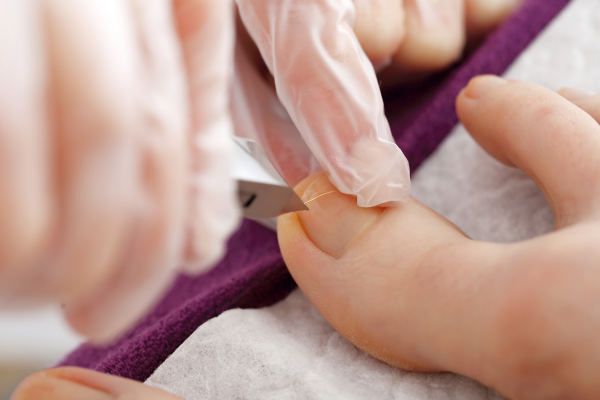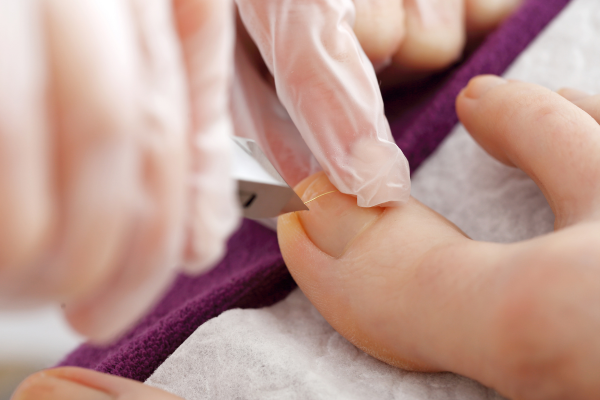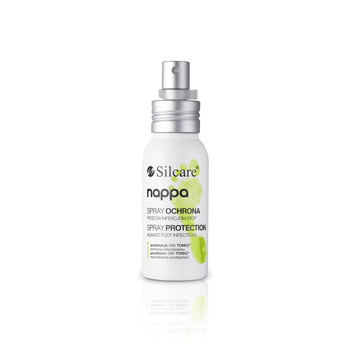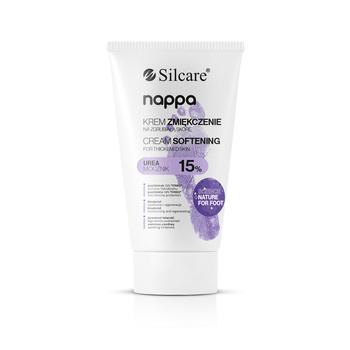What helps with an ingrown toenail? What are the causes and symptoms of this condition?


What is an ingrown toenail? How does a toenail become ingrown?
Ingrown toenails are one of the most common nail conditions. It affects people of all ages, but teenagers and adults are the most frequent sufferers. This issue usually appears on the toes, although it can sometimes occur on the hands as well.
Ingrown toenails occur when the nail plate penetrates the soft tissue surrounding it. Since the body treats the nail plate as a foreign object, this results in inflammation, discomfort, or associated pain. In later stages of the condition, an ingrown nail can lead to the formation of granulation tissue.
If left untreated, the problem of ingrown toenails often becomes chronic, recurring, and may lead to other health conditions that can even threaten overall health, such as ulcers, necrosis, or phlegmon.
See also: Green bacteria on the nail – how to treat it? What is Pseudomonas aeruginosa?
Ingrown toenails: Symptoms and causes
Symptoms of an ingrown toenail
In the early stages, an ingrown toenail may present with:
- Redness around the nail folds
- Inflammation
- Swelling
- Discomfort or pain, either only when pressed or persisting continuously.
In later stages, if untreated, the symptoms worsen and may also include:
- Discharge of pus, blood, or serum from under the nail plate
- Overgrowth of the nail fold
- Formation and enlargement of granulation tissue
- Nail deformation or change in shape
- Difficulty walking.
Causes of ingrown toenails
There are many factors that can lead to ingrown toenails. One of the most common is improper nail cutting, such as rounding the edges or cutting them too deeply. Another typical cause is inappropriate footwear – wearing high heels, shoes with narrow toe boxes, or ill-fitting shoes that are too small.
Other causes of ingrown toenails include:
- Genetic factors
- Natural shape and structure of the nails
- Orthopedic issues
- Mechanical injuries (common among athletes)
- Excessive foot sweating
- Adolescence
- Poor foot hygiene
- Certain medications
- Overweight
- Certain diseases (e.g., diabetes, venous insufficiency).
How to treat an ingrown toenail? Home remedies or a doctor's visit?
The treatment method for an ingrown toenail should be chosen based on the stage of the condition. If the problem is noticed early, changing habits and using home remedies may be enough to resolve it in many cases.
What home remedies help with ingrown toenails?
- Check that all the shoes you wear are comfortable, do not press on your feet, and do not cause sweating.
- Soak your feet several times a day in warm water with soap or special softening foot salts. Each soak should last at least 10 minutes.
- To soften the ingrown nail plate, apply petroleum jelly or a thick cream to it, then wrap it with a bandage.
- Use antibacterial agents from the pharmacy to prevent infection.
Where to go with an ingrown toenail? How to treat it?
If home remedies are not working or the ingrown toenail is causing other symptoms that interfere with daily life, it’s essential to see a doctor. A dermatologist, pediatrician, podiatrist, or surgeon can help treat this nail condition.
What are the most popular medical methods for treating ingrown toenails?
- Brace for ingrown toenails – it straightens the nail and gently lifts the edges to prevent further ingrowth into the skin.
- Ointment for ingrown toenails – helps reduce inflammation and pain.
- Surgery for ingrown toenails – sometimes the only effective treatment is surgical, such as periungual fold plastic surgery (removal of excess tissue around the nails) or resection (removal of the lateral problematic nail parts along with part of the periungual folds and nail bed).
- Taping or tamponade for ingrown toenails – placing special tape or cotton under the ingrown toenail can effectively stop the problem from progressing.
How to prevent ingrown toenails?
Proper hygiene and foot care are essential. Regular check-ups and medical pedicures with a podiatrist can help prevent recurrence. It’s also important not to trim toenails too short and to wear comfortable shoes made of breathable materials suited to current weather conditions.
What foot care should you choose?
A must is diligent foot hygiene.
See: Foot cosmetics – how to choose them for your needs?
Twice a week, it’s worth using special foot soaks, such as in Epsom Salt Nappa Soothing Foot Bath. Soaking feet in warm water with salt crystals softens the skin, reduces inflammation, relaxes muscles, and regulates foot perspiration.
Exfoliate your feet 1 or 2 times a week using Nappa Foot Exfoliating Scrub. This gentle yet highly effective scrub not only exfoliates but also provides a range of other benefits thanks to its plant-based oils. It boosts circulation, improves elasticity, smooths, and nourishes the skin.
An intensely moisturizing foot cream is essential for effective foot care. Opt for a cream with a high urea content. Our specialist Nappa line includes Foot Ointment for Rough Skin with 30% Urea. This innovative formula is rich in plant-based active ingredients, offering intense hydration, nourishment, protection, regeneration, and refreshment for your feet.
Take care of your feet professionally with Silcare!
Recommended

HELP TO… Gel UV/LED Quick Fix Myco 50 g

Professional cuticle scissors EXPERT 50 TYPE 1

Cuticle scissors SE-20/2

Cuticle Remover Preparation Orange 15 ml

NAPPA Cream moisturizing for daily care 5% urea150 ml

Nappa Microbiome protection feet Spray 55 ml

NAPPA Cream SOFTENING for thickened skin 15% UREA 150 ml























